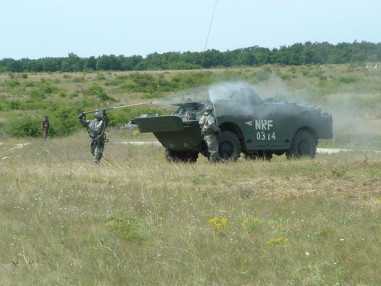Four Hours In The Sun In Full Protective Gear
Szöveg: Ferenc Demeter | 2009. július 7. 11:04The exercise of the Nuclear, Biological, and Chemical Alert System of the Hungarian Defence Forces was conducted with the participation of civil organizations this year, in attendance of the heads of the involved civil organizations, who had a chance to learn about the defence forces’ capabilities used in the reconnaissance and winding up of such situations.
The guests were greeted by Lieutenant General (Eng.) János Mikita, MoD Deputy Chief of Defence Staff, who emphasized: it is very important that they can act together with the organizations involved in NBC protection. “We have to adjust to the circumstances of modern warfare at all times. In the NATO plans, NBC protection is treated as a key area, since a possible contamination may endanger a vast number of the civil population. The protection of manpower is a very important task for both the army and the other civil organizations working in cooperation with the army. With this exercise we would like to show you the equipments of the corps and the cooperating organizations. At the same time, we want to explore possibilities to further improve our cooperation in the future. Therefore the aim of the exercise is to extend military capabilities by involving the equipments owned by civil organizations into NBC reconnaissance and the identification of the scale and type of contamination," summarized Lt.Gen. János Mikita.

During the first maneuvre of the exercise, aerial nuclear reconnaissance was conducted with a container onboard a MI-24 helicopter. The helicopter was flying a route chosen in advance above a supposedly contaminated terrain at an altitude of 100 meters. Inside the container on the helicopter, there were instruments detecting and forwading the information online to the computer of the Mobile Situation Assessment Team. They made every effort to locate the source of radiation and the level of contamination precisely. Meanwhile the guests were told by the instructor leading the exercise that the container was developed by Hungarians, and there are four of them in the country. With a container like this, they can carry out reconnaissance over an area of 300 square kilometers. They have installed it on a MI-24 because this type of helicopter has good armour protection that can significantly decrease the level of radiation, protecting those working on the aircraft. The exact location of the source of radiation was indicated by a red dot on the monitor of the situation assessment team’s computer.
As soon as the helicopter finished the aerial reconnaissance, nuclear reconnaissance was started on the ground, in cooperation with the selected forces of disaster prevention. This maneuver was conducted by VSBTR-80 armoured vehicles, ABV reconnaissance combat vehicles, and their measuring apparatus. With the instruments the boundaries of the contaminated terrain were located and they were marked with flags, and soil samples were taken. Similarly to the helicopter, the combat vehicles took a selected route, recording and forwarding radiation figures. Later two people got out of one of the combat vehicles and took samples, then got in the combat vehicle again following partial decontamination, in order not to take the contamination into the passenger compartment with them. As soon as the vehicles finished with marking the boundaries on the whole terrain they went to the decontamination area.
At the passing point the extent of contamination was measured and the vehicles underwent pre-treatment. First they were cleaned of the layers of dust and mud with high pressure water, followed by the main treatment, where materials neutralizing radiation, or in other cases chemical substances, were applied on the contaminated surfaces. The follow-up treatment was high pressure water again. Finally a control radiation level check was performed and if the value was below the allowed limit, the vehicle could leave the decontamination area.
In the meantime, in another exercise ground of the contaminated area, HAVARIA sampling and decontamination team was working in cooperation with the crew of the National Epidemiological Centre. They took soil samples and collected leaves, other plants, and carcasses of small animals. They put them in separate bags, labelled them, then put them in another airtight bag, and following that, into a hermetically sealed transport box. Taking samples under these circumstances may last more than four hours due to the high level security requirements, which is quite an ordeal out in the sun, dressed in full protective gear. Following the decontamination of the participants and the transport box, the samples were taken from the contaminated area to the national laboratory where further examinations were carried out. On the scene of the exercise the primary examinations are performed with the help of the Mobile Biological Laboratory Complex, after which regulations can be imposed to prevent the contamination from spreading further. This exercise was the first example for such a cooperation between military and civil organizations. These groups are primarily deployed in case of biological contamination to precisely identify the scale and type of the contamination.
In the static part of the exercise the equipments used by the troops in practice were on display: combat vehicles, decontamination equipments, nuclear and chemical contamination measuring apparatuses, personal and collective protective equipments. The guests were given detailed information about the use and specifications of these devices from the professionals. The mobile ABV reconnaissance vehicle of the disaster prevention corps, and its equipments were also on display. The defence forces displayed the simulation equipment of HDF ‘Artúr Görgey’ Chemical Protection Information Centre, which also run the exercise on the computer. Parallel to the computerized procession, the pieces of information were also processed on maps in a traditional way. After the data sent to the centre has been processed, state and military leaders are given a quick update on the situation of the disaster evolving in any area of the country.
Lt.Gen. János Mikita, who visited all the locations of the exercise, said: what he had seen was very useful and the cooperation with civil organizations was exemplary.